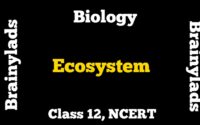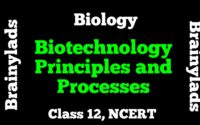Strategies for Enhancement in Food Production Class 12 | Biology |
Table of Contents
Strategies for Enhancement in Food Production Class 12, Biology in Human Welfare
Animal Husbandry
- Animal husbandry is the agricultural practice of breeding and raising livestock.
- It helps in increasing the food production along with plant breeding also.
- It involves caring and breeding of livestock such as buffaloes, cows, pigs, horses, cattle, sheep, camels, goats, bees silkworms etc. and also poultry farming and fisheries.
- fisheries include rearing selling etc. of fish, mollusks, prawn, crab etc.
- More than 70% livestock is in INDIA and CHINA
- But the contribution of farm produce is only 25% i.e. productivity is very low.
- Therefore new technologies are taken in use to improve quality and productivity.
Management of Farms and Farm Animals
- It includes traditional practices and procedures for management of farm and farm animals
Dairy Farm Management (Dairying)
- Management of animals for milk and its products for human consumption is dairying.
- it involves process and system to increase yield and improve quality of milk.
- The yield of milk depends upon quality of breeds.
- Good breeds have high yield and resistance to disease are selected.
For the yield potential –
- Cattle have to be looked after well
- Housed well
- Should have adequate water
- Maintained disease free
- Feeding of cattle should be in scientific manner
- Cleanliness and hygiene while milking, storage and transport of the milk.
To ensure the stringent measures there should be regular inspections with proper record and regular visits of veterinary doctor.
Poultry Farm Management
Poultry is the class of domesticated birds used for food and their eggs.
Chicken, ducks, turkey and geese are included in it.
Components of Poultry Farm Management
- Suitable and disease free breeds.
- Safe farm conditions.
- Proper feed and water.
- Health care
Animal Breeding
Breed is a group of animals related by descent and similar in most characters like general appearance, features, size, configuration etc.
- Animal breeding helps in increasing the yield of animal and improve desirable qualities of the produce.
Types of Breeding
Inbreeding
- It is a process of mating more closely related individuals within the same breed for 4-6 generations is called inbreeding.
Process
- Superior male and females of the same breed are identified and mated in pairs.
- The obtained progeny are evaluated and superior males and females are identified among them for further mating.
- Superior female produce more milk per lactation whereas a superior mall(bull) gives rise to superior progeny.
Advantages of Inbreeding
- it evolve a pureline animal by increasing homozygosity.
- it exposes harmful recessive genes that are eliminated by selection.
- in this process accumulation of superior genes and elimination of less desirable genes, this increases the productivity of inbred population.
Disadvantages of Inbreeding
- It may lead to inbreeding depression(continued inbreeding especially close breeding)
- To solve the problem of selected animals of the breeding population should be mated with unrelated superior animals of same breed which helps to restore fertility and yield .
Out-Breeding
- It is the breeding of unrelated animals which may be between individuals of same breed( but having no common ancestors) or between different breeds or different species
- It includes out crossing, cross- breeding and inter specific hybridization.
Out-Crossing
- This practice involves mating of animals within same breed having no common ancestors on either side of their pedigree up to 4-6 generations.
- Off-spring produced is known as out- cross.
- This is the best method for animals having low productivity in milk production, growth rate in beef cattle etc.
- It also overcome inbreeding depression.
Cross-Breeding
- In this, superior males of one breed are mated with superior females of another breed.
- In this method desirable qualities of two different breeds combine to form the progeny hybrid animals that may be used for commercial production or subjected to inbreeding and to develop new stable superior breeds.
- Example- Hisardale (sheep) developed in Punjab by crossing Bikaneri ewes and Marino rams .
Interspecific Hybridization
- It includes mating of male and female animals of two different species.
- Progeny formed may combine desirable features of both parents , and may be of considerable economic value.
- Example- Mule ( male ass * female horse)
Controlled Breeding Experiment
It includes:
a. Artificial insemination
- controlled breeding experiments are carried out using artificial insemination.
- in this method, the semen collected from the male parent is injected into the reproductive tract of selected female by breeder.
- semen collected may be immediately used or can be frozen and used later.
- semen can be transported in a frozen from where the female is housed to obtain desirable hybrid.
- success rate of crossing is even low though artificial insemination is carried out.
b. Multiple Ovulation Embryo Transfer Technology(MOET)
- This programme is for herd improvement i.e. to improve the chances of successful production of hybrids.
- In this method, a cow is administered with hormones like FSH to include follicular maturation and super ovulation to produce 6-8 eggs per cycle instead of one .
- The animal is either mated or artificially inseminated.
- This technologies is seen in cattle , sheep, rabbits, buffaloes, mares etc.
- High milk yielding breeds of females and high quality(lean lipid with less lipid) meat yielding bulls have been bred successfully to increase herd size in short time.
Bee keeping (Apiculture)
- It involves maintenance of hives of honey bees for the production of honey and beewax.
- Honey is of high nutritive and medicinal value.
- Bee wax produced by honey bees is used in formation of polishes, cosmetics etc.
- Bee keeping can be practiced in an area where there are sufficient bee pastures of wild shurbs , fruit orchards and cultivated crops.
- Apis indica is the most common species reared.
Important features for successful Bee Keeping
- Knowledge of nature and habits of bees.
- Suitable location for keeping beehives.
- Catching and hiving of swarms.
- Management of beehives during different seasons.
- Collection and handling of honey and of beewax.
- Keeping beehives in crop fields in flowering period increases pollination thereby increases crop and honey yield.
Fisheries
- It involves catching , processing or selling of fish , shellfish or other aquatic animals.
- Its development is called blue revolution.
- It includes :
a. freshwater fishes- Catla , Rohu , common carp etc.
b. marine fishes- Hilsa, Sardiness, Mackerel , Pomfrets etc.
Aquaculture is culturing of all aquatic organisms in fresh water , brackish and marine environment
Pisciculture is growing of only fishes and related food animals in water bodies.
# Strategies for Enhancement in Food Production
Do share this post if you liked Strategies for Enhancement in Food Production Class 12 . For more updates, keep logging on BrainyLads





